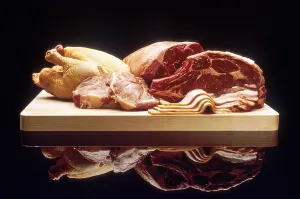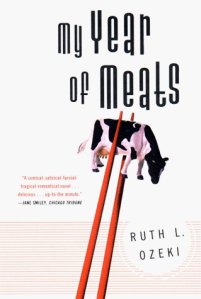In order to survive in this planet of ever-growing changes, shifts and changes are often made, leading to the discarding of past values and tradition. In Ruth Ozeki’s novel, My Year of Meats, Ozeki indicates a shift in Japan as a country, as a result of influences in capitalism, consumerism, and overall American Culture. Ozeki makes it increasingly evident that Japan is losing its identity amongst nations as Japan seeks to conform with societies which have been deemed successful and prosperous. Japan is shown to seek adaptations of cultural lifestyles with a change to a diet richer in meats and shift towards desires of the “American Dream.”
Clear resentment is presented towards past Japan through Akiko’s husband, John, who displays a growing loss of interest in his wife due to her small figure and infertility, which he views to be due to a meat-deficient diet. The remedy in such situation is concluded to be a change to a more American lifestyle, one that incorporates large consumption of meat. In such way, Ozeki utilizes meat as a linkage to American consumerism and culture, displaying shifting tides in Japan, as Japan becomes further accustomed to meat consumption through the cooking show, My American Wife, that Jane (the Protagonist) helps to produce. Ozeki essentially hints to the failure of infrastructure in Japan as a whole, as Japanese culture has caused its people to pale in comparison to American people.
The Protagonist Jane can be seen as the bridge between Japan and the America, as she is of Japanese and Caucasian decent. In presenting this duality, Ozeki is able to further the idea of American health and stature through both the successes of Jane with her TV show and Jane’s figure itself. John who comes into contact with Jane, in one passage, commends Jane on her height and intelligence, which he attributes to her Caucasian side. This sort of American favoritism that Ozeki incorporates into her novel, creates a sense of a dying Japanese culture that people seek to abandon for something of greater nourishment and prosperity. In My Year of Meats, this nourishment comes in the form of the meat that is cooked on the show and the meat that is sold to the Japanese people through BEEF-EX. The early Meiji Era values of 19th century Japan, values that include buddhist ideals of being frugal, low meat consumption, and overall moderation, are discarded and replaced with American values of excessiveness and high consumerism (in particular with that of meat). This new 20th century Japan, illustrates Japanese high regard toward a state of modernity, which is thought to be only possible through the mimicry of “American culture.”
My Year of Meats is a novel in which Japanese progression towards modernity in the 19th and 20th century is displayed through Japanese adaptations toward the American lifestyle. Ozeki displays such shift through the symbol of meat which becomes an increasingly common part of the Japanese peoples’ lives. American consumerism is placed at the utmost highest pedestal, as it emanates and produces prosperity and health which is shown through the juxtaposition of American and Japanese women.



